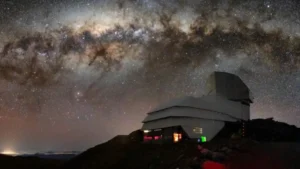Well, NASA officially needs a Captain Planet-style promo video.
The space agency’s recent test of its Earth defense system proved more successful than expected. By crashing a probe into an asteroid called Dimorphos last month, NASA changed the small, rocky body’s course, setting an important precedent for deterring real threats in the future.
“We conducted humanity’s first planetary defense test,” said Bill Nelson, the administrator of NASA. “And we showed the world that NASA is serious as a defender of this planet.”
In November 2021, NASA began the Double Asteroid Redirection Test, or DART. The agency’s engineers designed a spacecraft no bigger than a household fridge. Its mission: self-destruction.
On September 26, the spacecraft reached 23,000kph before crashing into Dimorphos, a small moon orbiting a near-Earth asteroid named Didymos.
NASA confirmed Tuesday that the test had worked. Astronomers saw a measurable difference in Dimophos’ orbit around Didymos.
“All of us have a responsibility to protect our home planet. After all, it’s the only one we have,” Nelson said.
In a bit of smart publicity, NASA even live-streamed DART’s kamikaze mission, which you can watch below.
A changed course
Before DART destroyed itself against the surface of Dimorphos, the small moon orbited its larger planet asteroid in 11 hours and 55 minutes.
Watching closely since September 26, NASA’s space investigators concluded that the collision had altered Dimorphos’ orbit around Didymos by 32 minutes. That means the collision had shortened its orbit to 11 hours and 23 minutes.
The change is far better than NASA expected. Before the crash, NASA had defined a minimum successful orbit change of Dimorphos as 73 seconds or more. This early data show DART surpassed that benchmark by more than 25 times.
“This result is one important step toward understanding the full effect of DART’s impact with its target asteroid,” said Lori Glaze, director of NASA’s Planetary Science Division at NASA Headquarters in Washington. “As new data come in each day, astronomers will be able to better assess whether, and how, a mission like DART could be used in the future to help protect Earth from a collision with an asteroid, if we ever discover one headed our way.”
Researchers all over the planet will continue to study the collision.
In about four years, the European Space Agency’s Hera project will conduct surveys of both Dimorphos and Didymos. The agency’s engineers will focus their attention on the crater left by DART’s collision and gaining a precise measurement of Dimorphos’ mass.
Learn more about the DART mission here.






